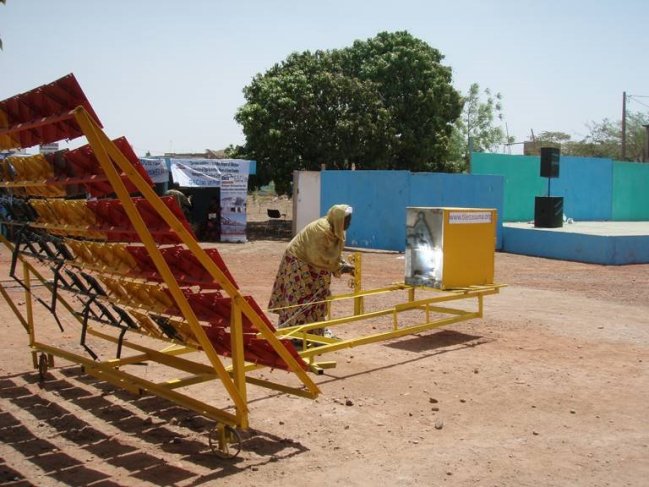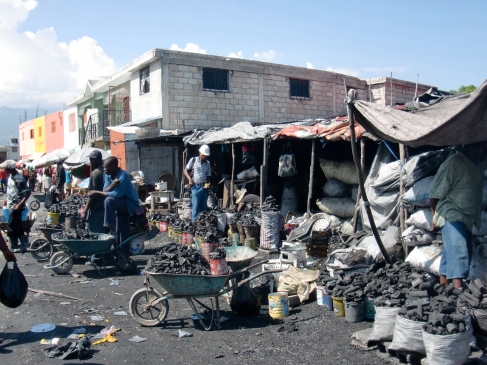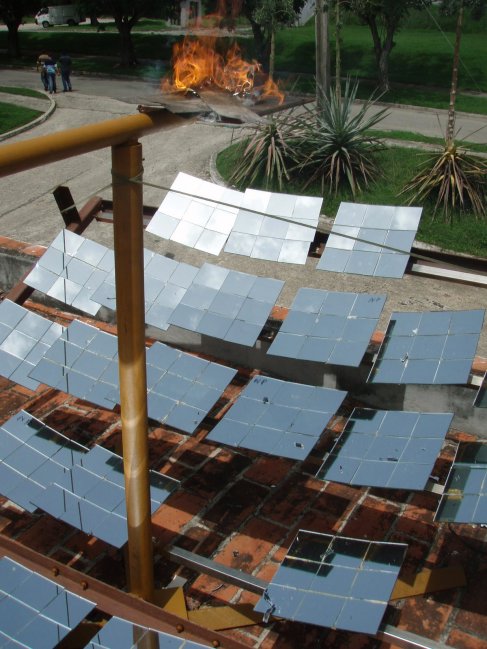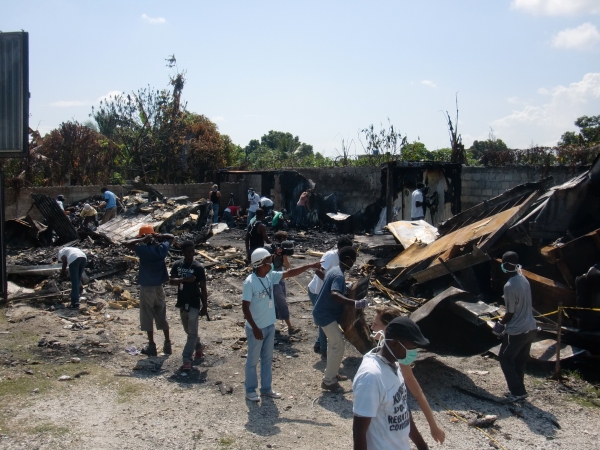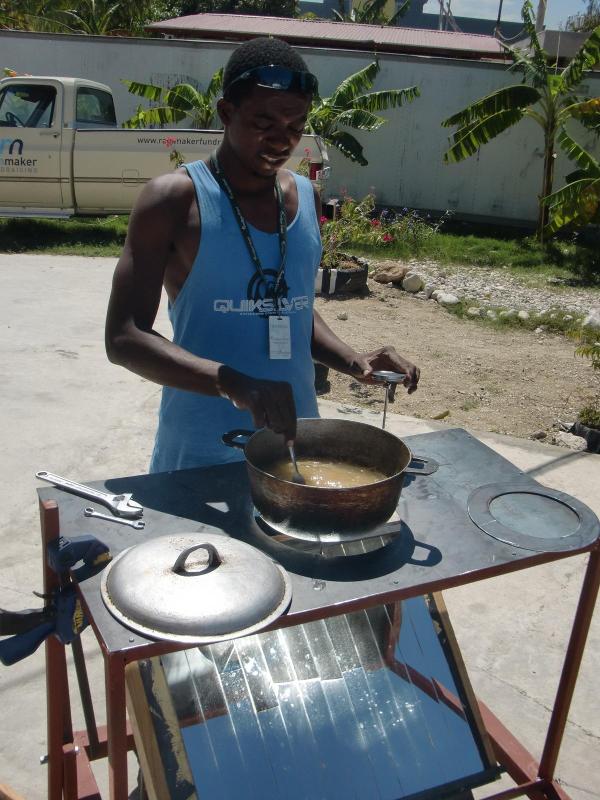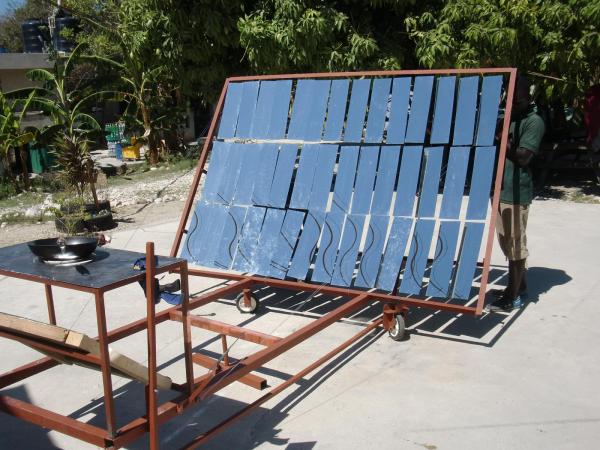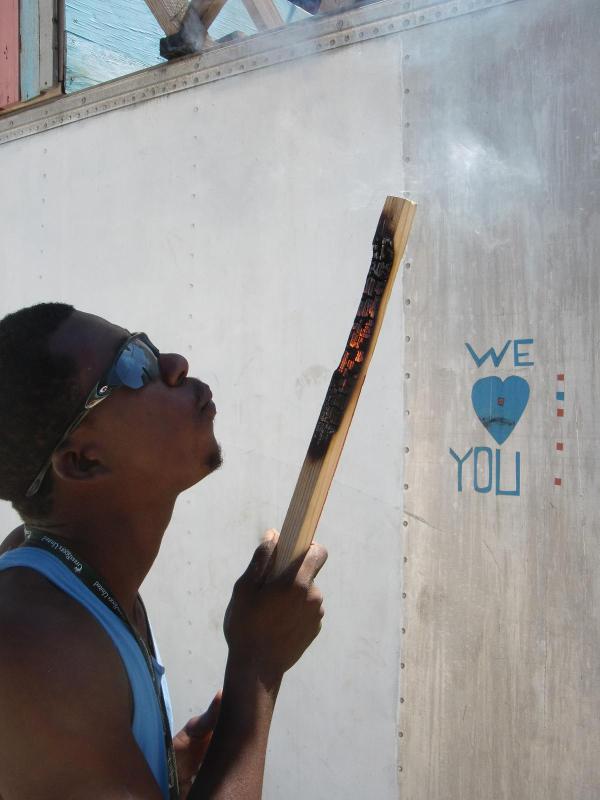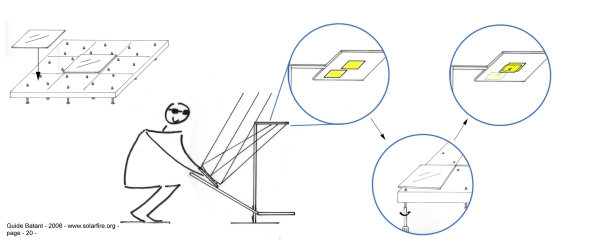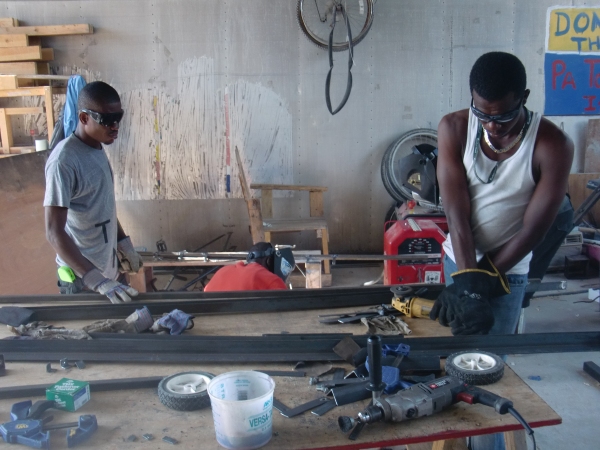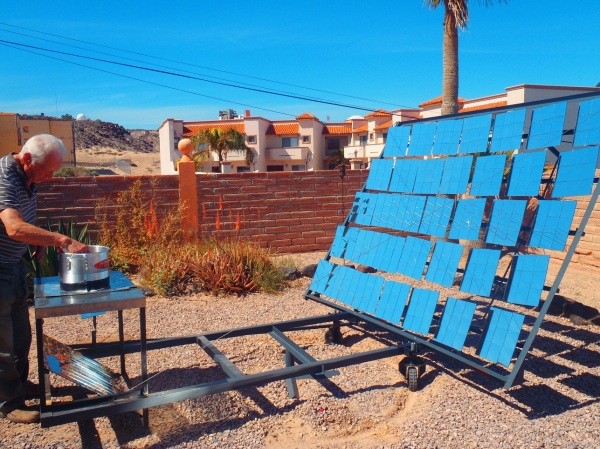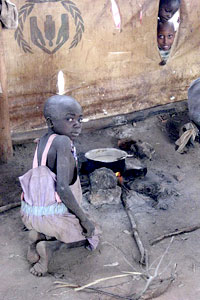GoSol – Solar Energy for ALL
Onwards and upwards! Ladies and gentlemen, I’ve extremely proud to present you with the amazing group of humans with whom I’m working alongside to ensure that every person on the planet has access to the energy that they need to live sustainable, healthy, fulfilled lives:
Check out this video introduction to the GoSol.org team.
It’s a tremendous learning experience working with these intelligent, creative and caring people. We all come from different countries and have very different backgrounds and skill sets but we share the same objective – empower everyone.
We’ve created GoSol.org which is the hub from which we will be spreading our concentrated solar thermal solutions.
If you’ve been following this blog for a while you know how big an issue heat energy is for billions of people across the developing world. You also know about the extraordinary abundance of sunlight falling from the sky.
GoSol.org is where the action is these days, but I’ll be sure to post some memorable stories here over the course of the next year, which will be remembered as the year it happened.
Make sure to ‘Like’ us on Facebook.
Follow @GoSolOrg on Twitter,
And follow me on Twitter while you’re at it: @Lorington
Solar Cooking and the Millenium Development Goals
Right, now hear this! Solar cooking promotes all eight of the United Nations Millenium Development Goals. More sunlight falls on the earth in an hour than all of our industrialized civilization uses in a whole year. There is no shortage of energy. Energy poverty is simply a consequence of foolish development. Widespread use of concentrating solar technologies (many of which are very low tech) will solve pretty much all the problems our species is facing.
I adapted the following text from http://solarcooking.wikia.com/wiki/United_Nations_Millennium_Development_Goals
Solar Cooking and the United Nations Millennium Development Goals
Solar cooking contributes to reaching all eight of the United Nations Millennium Development Goals (MDGs). Participation of women is vital to achieving the MDGs, yet it is difficult or impossible for many poor, rural women and girls because of time-consuming fuel-gathering and cooking. “The time women and girls and spend on routine tasks can be reduced dramatically … (with) efficient sources of energy – especially new forms of fuel for cooking and heating.”[1]
Widespread access to low-cost, high-power solar cookers to pasteurize water and cook food with free sunshine is a proven ‘quick win’ as defined in the UN Secretary-General’s Report: Relatively inexpensive, high impact initiatives with the potential to generate major cumulative short-term gains and save millions of lives.
Low-tech, high-power solar cookers allow value adding to products, combat indoor air pollution, reduce the burden placed on families by the high costs of cooking fuel, protect areas at risk of deforestation and enhance sanitation while lessening needless burdens for women and girls. Institution-sized solar cookers for refugee camps, hospitals, orphanages and schools are also cost effective.[2] In new areas modest funding for 3-5 years 1) creates public awareness, 2) provides initial consumer education and follow-up, 3) starts up local production, and 4) trains local women to start small businesses.
Goal 1: Eradicate extreme poverty and hunger
Many families living on less than one dollar a day per person spend 1/3 of it for cooking fuel. This cost often means less food to eat and rarely includes pasteurizing water or warming wash water. Solar cookers typically reduce fuel needs by at least 1/3 [3][4][5] and, depending on the price of cooking fuel, can pay for themselves in as little as two months of fuel savings.[6] Additionally, having a source of cheap, clean solar thermal energy enables producers to preserve seasonal harvests by dehydrating crops, thereby improving nutrition for the rest of the year. Improved maternal health and the ability to pasteurize water reduce the incidence of disease, the opportunity and treatment cost of which is an important factor in global poverty.
Goal 2: Achieve universal primary education
In many developing countries, girls start helping collect wood at a young age. Wood is now scarce for two billion people [7], and about half live in sun-rich areas. Long journeys to gather small brush, crop residues and dung for cooking fuel take time from school attendance and studies. Solar cookers need only sunlight, freeing boys and girls to spend more time in school.
Goal 3: Promote gender equality and empower women
Primarily women and girls spend hours gathering fuel, cooking food, tending fires, and suffer extra health hazards due to indoor air pollution and smoke. Solar cookers require no fuel-gathering and produce no smoke or soot, freeing time to pursue education, increase food quality and quantity, and generate additional income. The European Commission and solar cooker experts estimate that 165 to 200 million households could benefit from solar cookers.[8][9]
Goal 4: Reduce child mortality
Waterborne and smoke-related diseases are the primary killers of children.[10] When fuel is scarce and expensive, it is hard to heed public health messages about boiling water. Every solar-cooked meal is smoke-free and solar cookers easily pasteurize water and milk.
Goal 5: Improve maternal health
Smoke from cooking fires is the major killer of young women in developing countries and is linked to low-birth weight and infant mortality.[11] Fuel-gathering in some areas expose women to violent assaults. Solar cooking is clean and smoke-free, and benefits the health of all family members.
Goal 6: Combat HIV/AIDS, malaria and other diseases
Gathering firewood, working to buy firewood and caring for a sick family member and orphans takes time away from livelihood activities. Diarrhea due to unclean water is responsible for 1.8 million deaths every year [12] and free solar powered water pasteurization protects whole families. Every year, Indoor Air Pollution (IAP) kills 1.5 million people, primarily women and children. [13] Reducing the amount of resources spent fighting diarrhea and complications from IAP equates to a greater ability to combat AIDS/HIV, malaria, etc
Goal 7: Ensure environmental sustainability
One-third of humanity has only wood, charcoal or poor substitutes to cook daily meals. When wood becomes scarce, cooking is done by burning dung and crop residues, which should be returned to the soil. A small solar cooker saves about one ton of wood per year [14] thereby reducing carbon dioxide emissions by 1.8 tons per year [15]. Deforestation and desertification are exacerbated by unsustainable use of wood and charcoal as cooking fuels. While burning wood is carbon neutral, decreasing the amount of wood used, thereby increasing forest cover, amounts to sequestering carbon.
Goal 8: Develop a global partnership for development
Creating widespread access to solar cookers involves mutually beneficial participation of government, commercial and humanitarian sectors, and complements broader local, national and international activities toward all of the MDGs. Monetizing the global carbon market is a complex task, but one that would see solar cooking implemented around the world.
References
[1] UN Millennium Project Task Force on Education and Gender Equality 2005, Taking action: achieving gender equality and empowering women, International Center for Research on Women (ICRW), 2005
[2] Scheffler, W. & Sutter, C., Evaluation of solar community kitchens in Gujarat, Proceedings of the Third international conference on solar cookers use and technology, Coimbatore, India, 1997
[3] Palmer, R., Kota, M. & Wenzel, M. The DME/GTZ solar cooking field test in South Africa: a study in end-user acceptance and pilot commercial dissemination. Proceedings of the International Conference on Solar Cooking 7-29 November 2000 (pp. 41-49). Kimberley, South Africa: Department of Minerals and Energ, 2000
[4] Konde, A., Aisha Solar Cooking Project Evaluation, Solar Cookers International, 2002
[5] Center for Independent research and Energy for Sustainable Development Africa, Evaluation of the Solar Cooker Project in Kakuma refugee camp 2003. Unpublished, Solar Cookers International archives, 2003
[6] Solar Cookers International Sunny Solutions Project in Nyakach, Kenya, 2005
[7] Varese Declaration, World Solar Cooking and Food Processing Conference, UNESCO, 1999; also, Food and Agriculture Organization (FAO), State of the world’s forests. Oxford: Oxford University Press, 1997
[8] Ossenbrink, H., Opening remarks by European Commission Head of Renewable Energies Unit, Proceedings of World solar cooking and food processing conference, Varese Italy, UNESCO, 1999
[9] Grupp, M., The untapped market for solar cookers, Solar Box Journal, 1994
[10] World Health Organization
[11] ibid.
[12] UNICEF and WHO report: Diarrhoea: Why Children are Still Dying and what can be done
[13] WHO report: Fuel for Life: Household Energy and Health
[14] Many solar cooker projects, including Heibi, China; South Africa Mines & Minerals
[15] Thorne, S. & S. Raubenheimer, Evaluation of a potential in attracting finance through Clean Development Mechnisms – Solar cookers and carbon mitigation possibilities, Energy transformations, South Africa, 2003
What is Solar Fire? RSAnimate style…
This is a short video showing the basics of Solar Fire Technologies… what it is, what it does and why.
Solar Cooking and the UN Millenium Development Goals
Adapted from SCWN by Lorin Symington
United Nations Millennium Development Goals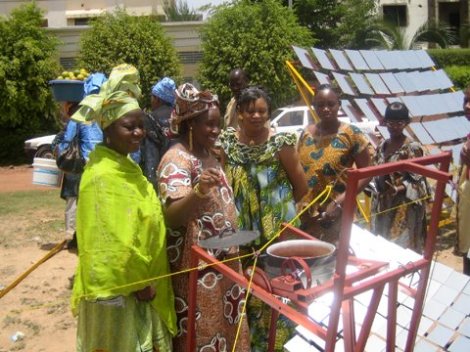
Solar cooking contributes to reaching all eight of the United Nations Millennium Development Goals (MDGs). Participation of women is vital to achieving the MDGs, yet it is difficult or impossible for many poor, rural women and girls because of time-consuming fuel-gathering and cooking. “The time women and girls and spend on routine tasks can be reduced dramatically …(with) efficient sources of energy – especially new forms of fuel for cooking and heating.”[1]
See www.astraonline.ca for details about one of the most cost effective solar cookers.
Widespread access to low-cost, high-power solar cookers to pasteurize water and cook food with free sunshine is a proven ‘quick win’ as defined in the UN Secretary-General’s Report: Relatively inexpensive, high impact initiatives with the potential to generate major short-term gains and save millions of lives.
Low-tech, high-power solar cookers, permit value adding to products, combat indoor air pollution, reduce the burden placed on families by the high costs of cooking fuel, protect areas at risk of deforestation and enhance sanitation while lessening needless burdens for women and girls. Institution-sized solar cookers for refugee camps, hospitals, orphanages and schools are also cost effective.[2]
In new areas modest funding for 3-5 years 1) creates public awareness, 2) provides initial consumer education and follow-up, 3) starts up local production, and 4) trains local women to start small businesses.
Goal 1: Eradicate extreme poverty and hunger
Many families living on less than one dollar a day spend 1/3 of it for cooking fuel. This cost often means less food to eat and rarely includes pasteurizing water or warming wash water. Solar cookers typically reduce fuel needs by at least 1/3 [3][4][5] and, depending on the price of cooking fuel, can pay for themselves in as little as two months of fuel savings.[6] Additionally, having a source of cheap, clean solar thermal energy enables producers to preserve seasonal harvests by dehydrating crops, thereby improving nutrition the rest of the year. Improved maternal health and the ability to pasteurize water reduce the incidence of disease, the opportunity and treatment cost of which is an important factor in global poverty.
Goal 2: Achieve universal primary education
In many developing countries, girls start helping collect wood at a young age. Wood is now scarce for two billion people[7], and about half live in sun-rich areas. Long journeys to gather small brush, crop residues and dung for cooking fuel take time from school attendance and studies. Solar cookers need only sunlight, freeing boys and girls to spend more time in school.
Goal 3: Promote gender equality and empower women
Primarily women and girls spend hours gathering fuel, cooking food, tending fires, and suffer extra health hazards due to indoor air pollution and smoke. Solar cookers require no fuel-gathering and produce no smoke or soot, freeing time to pursue education, increase food quality and production and generate additional income. The European Commission and solar cooker experts estimate that 165 to 200 million households could benefit from solar cookers.[8][9]
Goal 4: Reduce child mortality
Waterborne and smoke-related diseases are the primary killers of children.[10] When fuel is scarce and expensive, it is hard to heed public health messages about boiling water. Every solar-cooked meal is smoke-free and solar cookers easily pasteurize water and milk.
Goal 5: Improve maternal health
Smoke from cooking fires is the major killer of young women in developing countries and is linked to low-birth weight and infant mortality.[11] Fuel-gathering in some areas expose women to violent assaults. Solar cooking is clean and smoke-free, and benefits the health of all family members.
Goal 6: Combat HIV/AIDS, malaria and other diseases
Gathering firewood, working to buy firewood and caring for a sick family member and orphans takes time away from livelihood activities. Diarrhea due to unclean water is responsible for 1.8 million deaths every year [12] and free solar powered water pasteurization protects whole families. Every year, Indoor Air Pollution (IAP) kills 1.5 million people, primarily women and children. [13] Reducing the amount of resources spent fighting diarrhea and complications from IAP equates to a greater ability to combat AIDS/HIV, malaria, etc.
Goal 7: Ensure environmental sustainability
One-third of humanity has only wood, charcoal or poor substitutes to cook daily meals. When wood becomes scarce, cooking is done by burning dung and crop residues, which should be returned to the soil. A small solar cooker saves about one ton of wood per year[14] thereby reducing carbon dioxide emissions by 1.8 tons per year. [15] Deforestation and desertification are exacerbated by unsustainable use of wood and charcoal as cooking fuels. While burning wood is carbon neutral, decreasing the amount of wood used, thereby increasing forest cover, amounts to sequestering carbon.
Goal 8: Develop a global partnership for development
Creating widespread access to solar cookers involves mutually beneficial participation of government, commercial and humanitarian sectors, and complements broader local, national and international activities toward all of the MDGs.
References
[1] UN Millennium Project Task Force on Education and Gender Equality 2005, Taking action: achieving gender equality and empowering women, International Center for Research on Women (ICRW), 2005 [2] Scheffler, W. & Sutter, C., Evaluation of solar community kitchens in Gujarat, Proceedings of the Third international conference on solar cookers use and technology, Coimbatore, India, 1997 [3] Palmer, R., Kota, M. & Wenzel, M. The DME/GTZ solar cooking field test in South Africa: a study in end-user acceptance and pilot commercial dissemination. Proceedings of the International Conference on Solar Cooking 7-29 November 2000 (pp. 41-49). Kimberley, South Africa: Department of Minerals and Energ, 2000 [4] Konde, A., Aisha Solar Cooking Project Evaluation, Solar Cookers International, 2002 [5] Center for Independent research and Energy for Sustainable Development Africa, Evaluation of the Solar Cooker Project in Kakuma refugee camp 2003. Unpublished, Solar Cookers International archives, 2003 [6] Solar Cookers International Sunny Solutions Project in Nyakach, Kenya, 2005 [7] Varese Declaration, World Solar Cooking and Food Processing Conference, UNESCO, 1999; also, Food and Agriculture Organization (FAO), State of the world’s forests. Oxford: Oxford University Press, 1997 [8] Ossenbrink, H., Opening remarks by European Commission Head of Renewable Energies Unit, Proceedings of World solar cooking and food processing conference, Varese Italy, UNESCO, 1999 [9] Grupp, M., The untapped market for solar cookers, Solar Box Journal, 1994 [10] World Health Organization [11] ibid. [12] UNICEF and WHO report: Diarrhoea: Why Children are Still Dying and what can be done [13] WHO report: Fuel for Life: Household Energy and Health[14] Many solar cooker projects, including Heibi, China; South Africa Mines & Minerals [15] Thorne, S. & S. Raubenheimer, Evaluation of a potential in attracting finance through Clean Development Mechnisms – Solar cookers and carbon mitigation possibilities, Energy transformations, South Africa, 2003
Adapted from http://solarcooking.wikia.com/wiki/United_Nations_Millennium_Development_Goals
Disaster Strikes (struck) again, but this time, more personally.
Workshop, warehouse and work, wiped out in an afternoon. An afternoon 6 months ago, granted, but I’m just getting around to writing about it now.
Nobody was hurt. It was an accident while too many people working on too many projects were in the shop at once.
 You can see the array in the bottom left. A couple of mirrors cracked from the heat before people dragged it away. The work it took to fix was insignificant compared to the work that went up in smoke. I was nearly done a second array, had built a full compliment of plaster molds, as I was going to illustrate both mirror concentrating techniques, and the guys and I had built an oven that we were going bake pizzas in.
You can see the array in the bottom left. A couple of mirrors cracked from the heat before people dragged it away. The work it took to fix was insignificant compared to the work that went up in smoke. I was nearly done a second array, had built a full compliment of plaster molds, as I was going to illustrate both mirror concentrating techniques, and the guys and I had built an oven that we were going bake pizzas in.
I was just a couple of weeks away from really launching the project. Up to that point, numerous visitors to HC from around Haiti and the world had seen the project, but I was working on a targeted campaign to invite particularly relevant people and organizations.
Alas, I was needed otherwise. 3 shipping containers burnt to the ground and another two filled with charred supplies. All of it had to go; Haiti Communitere was committed to rebuild. I was well enough suited to get the job done and so the lads and I carved up and sorted the remains of the containers and sold the lot of it for scrap.
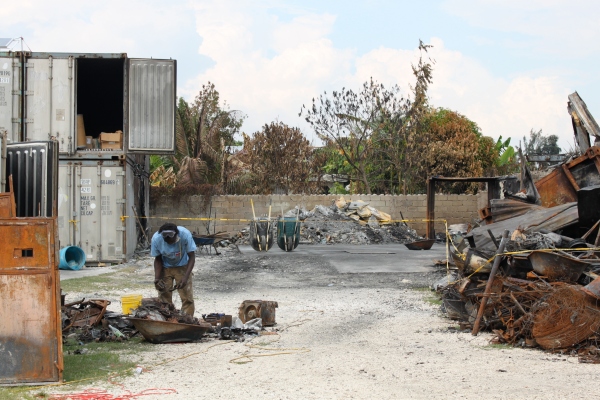
The community that has formed HC really came together and our friends in Cite Soleil threw a ‘Konbit’ which is a ‘putting together of hands’.
The health of a community is tied to its resilience and it didn’t take long for talk at HC to turn towards the future. The slogan of “Building Back Better” is one that everyone who has done work in Haiti since the earthquake is familiar with. HC, in its way, made that happen. Before the cleanup was done, they were out in the ether fundraising to build another, better workshop.
Once the cleanup was done, we built a temporary workshop. I made the call that I didn’t have the money and so the time (nor to be honest, the desire) to build back and go through with the Solar Project at the time. So I took an interesting offer to help Kevin from Fuego del Sol to build a briquette press that compresses waste paper, cardboard and sawdust into bricks that once dried, can be burned to cook food in stoves built by the UN (for which there is no ready supply of bricks). Check out the guys making bricks:
But then it was time to leave and regroup. Am still doing so, but really want to get back to Haiti. Nothing I saw there dissuaded me from the believe that there’s an explosive business model that uses Solar Fire to provide staple foods to people cheaper and easier than they can do it themselves. Only they will do it themselves, because hopefully the Haitians will cut us out of the market.
Are you a grant-writer or a fundraising professional? I could use a hand!
In the meantime, I present to you the bigger, better, awesomer, re-visioned maker-space at Haiti Communitere:

Good luck and keep your eyes peeled for more. I might toss a few documents out there and see if anyone’s willing to put in some time helping me to write copy and polish up what I’ve got.
Solar Spaghetti in Haiti
We’ve built the first Haitian Phaeton solar cooking array in Port-au-Prince and we’ve celebrated by making a big batch of spaghetti!
Above, you can see Junior stirring up the noodles above the upward reflector, which provides a convenient, waist high cooking console.
Above, Pena works on the focal point, learning how to adjust the mirrors to make the resulting reflection smaller and thus hotter.
Here Junior blows on the coals after a traditional stick burning. It’s odd, everywhere I’ve been, you can tell people about 2000 watts, that it will boil 12L of water per hour, that the maximum temperature of the focal point is around 600C but nothing gets them WOWing like a flaming stick!
This was an experimental model, with new individual mirror concentrating devices, and they have their pros and cons, so for completeness’ sake we’re going to build another Phaeton using the old favorite 9 facet mirror module technique illustrated below…
There’s more to it than that and I’ll post an instructional video once we’re gone through the process, but it results in a better concentration ration. It is more complicated and involves the use of fiberglass, which is a whole other sometimes hard to find material.
Tomorrow, I’ll buy more materials, and we’ll start making an oven. Meanwhile, I’ll train the guys how to make the 9 facet mirrors.
The rainy season is starting to make itself felt… clouds start to form towards 5 o’clock and then it starts to pour just after dark. So far it hasn’t interfered with daily operations but we’re only just starting to feel the effects.
By the weekend we’ll be baking pizza!
Solar cooker construction training in Haiti
Better late than never, right?
After a couple weeks of exploring, a false start in the Dominican Republic, and a week of nothing (due to Carnaval), we are finally full on into building the first Solar Fire Phaeton arrays in Haiti!
Pictured, are Yom and Junior, of Eiffel Tower fame. They are two enterprising young gents from Cité Soleil, one of the most dangerous and impoverished slums in the western hemisphere. They are eager to learn and have the skills to get the job done. I was introduced to them by the fine folks here at Haiti Communitere.
HC is an outstanding organization here in Port-au-Prince. They have a secure compound with all sorts of elements which help people to start projects in Haiti. It is a sort of working hostel, where weary travelers have a place to rest their heads, and where they can lend a hand to longer term partner-projects who have ongoing activities here on base or out in the city. The Eiffel Tower project was one such initiative, and Junior and Yom got to know the HC team, and the workshop, so they were naturals for the first round of training. They are very excited to receive their training, certificate of course completion from ASTRA and honorary printed and bound construction manuals.
We should be done construction in the next couple of days, and be cooking by the weekend!
In other news, Dani has gone back to Canada, but not before she Grooved some kids at a local orphanage! Check out this video I shot:
I’ll post a more context post soon enough, but internet is rather spotty and pictures tell the story best…
Suffice it to say that there is a lot of action here in Haiti… not nearly as much rubble as I had been led to believe, at least not in the streets. Still many collapsed buildings around town, terrible garbage, and lots of street folks, but for every person on the street that tells you (me) or ‘whitey’ (blanc) to get out of Haiti, there are two who will smile and shake your hand and want to know what you’re up to, or what it’s like in your country. The tent cities are huge and widespread and sad sights to behold, but a lot of them have (near) adequate sanitation now, as well as solar panel ‘street’ lights. As a matter of fact the other day as I was riding a taptap I saw an group of enterprising individuals who had used a pickup truck and a cable to pull one of said streetlights down and were busy harvesting the valuable solar panel for sale on the black market.
I’m loving the food, and the weather, but storms are more frequent these days and the rainy season is moving in. Mosquitos abound but I have my trusty rechargeable bug zapper racket which I am using every 20 seconds to sweep my vicinity clear of the buggers.
Lots of work planned for the next couple of weeks… We’ll build two Phaetons and one oven. Further more we’re doing a revamp of the www.astraonline.ca website (courtesy of Elisha), as well as compiling a list of NGOs and potentially interested parties so that when the Phaeton arrays are finished we can do a couple of weeks of inviting and demonstrating in the hopes of teaming up with organizations with the resources to take Solar Fire mainstream in Haiti.
Solar Fire in India!! Solar Steam engine!
A number of months ago I posted about Eerik Wissenz from solarfire.org collaborating with V K Desai of Tinytech in India. They first built a 10sqM concentrator, then a 32sqM version and Mr. Desaiji has now completed a 90sqM concentrator, pushing Solar Fire technologies into the industrial realm.
Huge and beautiful, this machine will cook for thousands of people per day or run machinery for local industry.
I am captivated by the possibilities for this machine in Haiti. While institutional cooking is very exciting, I think this thing powering a rubble crusher in Port au Prince or in one of the nearby rubble fields could be tremendously empowering. Right now, the removal of rubble is very industrial, with dump trucks running huge bins of rubble to the outskirts where huge machines break them down. See this PBS story.
Rubble crushing is one thing, but this concentrator further lowers the cost of high quality solar thermal energy, something that I believe will be essential to the sustainable development of Haiti.
Mr Desai of Tinytech expounds on his system in a post at HEDON.
Symington Solar Fire goes to Haiti
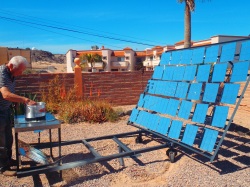
On the eve of my departure to Haiti, I though’t I’d write a precis of this solar cooking project detailing history, context, resources, ideas, strategies and the tremendous potential of Solar Fire technologies. Here it is.
Context: We live in a rapidly globalizing world dependent on fossil fuels, where 10% of the population use 70% of the resources. We passed the 7 billion population mark not long ago and population growth continues to rise exponentially. Jeffrey Sachs, Economist, Professor, Director of the Earth Institute just released a powerful op-ed piece in support of UN Secretary General Ban Ki Moon’s declaration that sustainable development is at the top of the agenda for 2012.
Sachs and Moon echo the core message of visionary Bill Gates’ TED talk. To my ears, that talk is aimed directly at me, though Gates makes no mention of solar cooking, it meets his criteria. In the talk he says ‘If you want to do something for the poor people of the world, lower the cost of energy’. Energy makes the world go ’round, after all. He goes on to provide an equation as a guideline… PxSxExC=C02 which demonstrates that it is not enough to simply lower the cost of energy if that energy is coming from dirty sources… you’ve got to lower the cost of energy while virtually eliminating carbon emissions. Well Mr. Gates, I believe my family and I have done that.
History: Visiting India in the late 80’s my father Tracy Symington was vexed by the extreme energy poverty that he witnessed. In a country where more than enough sunlight falls to power all of modern industrial civilization, people were burning dung and twigs to cook their meals. He challenged my grandfather Fraser Symington to design a machine that would allow people in developing countries around the world to harness the power of the sun. Together, we have created ASTRA the Agency For Solar Technology Research & Application, a Canadian not-for-profit corporation and after 20 years of independent R&D we have come up with the most cost effective, user friendly, accessible and versatile solar cooking technology in the world today:
Retail material cost: $364, peak output 2000W for the rock bottom price of $.055/W. The machine will last 30 years and pays off its carbon debt in around 4 months.
If you want to do something for the poor people of the world, lower the cost of energy. Aye Aye, capitan. What better place to do that than Haiti? The poorest nation in the western hemisphere, has been devastated even further by the 2010 earthquake. 80% of the population survives on less than 2$ per day and many families pay 25% of their daily income to buy fuel to cook. Charcoal: scourge of the forests, lung defiler, filthy and inefficient. Indoor Air Pollution is responsible for the deaths of 2 million people each year worldwide, and is the second greatest killer of children under five. 90% of Haitians use charcoal to cook and the result is

Haiti has about 15 years of trees left. They have no native fossil fuels. They have no money to buy such from abroad. Solar energy is the only way that they will have enough energy to create wealth and prosperity at the grassroots level. It is a universally accessible resource that is abundant and free. All people need is a way to harness it. I intend to provide them with a method for doing so.
I don’t know who, how, what or where, but I know that the opportunity to successfully implement and massively expand the use of solar cooking exists in Haiti and it is my goal to find the best way to do so. I have a lot of ideas and strategies, some of which have been detailed in previous posts, but I am not settling on a path until I have spent time on the ground, familiarizing myself with the country and getting to know her people and their ways. Whether through government, NGOs, philanthropy or private enterprise, I intend to share my knowledge of this technology and create an open-source business model that will free billions from toil and the grinding struggle of energy poverty.
I am leaving my home with no clear path, just a goal and a very limited amount of personal resources, but I know the strength of this idea, the value of this energy and I’ve no doubt that a way will present itself.
Next time I write, I will be in Port Au Prince.
Peace, Love, Hope
~L
Cooking with charcoal
This is what we’re up against. 80% of Haiti’s population cooks with charcoal and it is an expensive and dirty daily grind.
I’ve booked my ticket to Port Au Prince for February 1st 2012 and have been devouring documentaries and aid worker blogs and news articles, trying to get a handle on what is going on.
I’ve softened my approach in that I’m trying to remain as flexible as I can, going in with few to no fixed plans and plan to float-like-a-butterfly-sting-like-a-bee by assessing the situation and determining where and how the potential of Solar Fire technologies would be best demonstrated.
I’m taking some Creole lessons @ Haiti Hub so that I’ll be able to communicate once I’ve got boots on the ground… watching documentaries has illustrated that even being fluent in French might not help as much as I had thought…
Got a logo made, revamping the ASTRA website and soon to commence working through my ‘To Contact’ list that I’ve compiled over the past year to see if I can eet up with some solid folks doing good work and get myself oriented.
3 weeks till go time.


